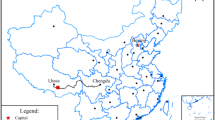Abstract
Penetration grouting is used to improve rock conditions under dams and foundations. So far no comprehensive ranking has been presented for the rock groutability assessment. However, a need for an index is tangible to classify the jointed rock masses from cement-based grouting conditions point of view. In this paper an attempt has been made to propose a rock groutability index (RGI) based on the rock engineering systems (RES). RES is an approach to evaluate the interrelationship between the factors affecting rock engineering activities. After discussing the rock grouting mechanism and identifying all the effective factors, an interaction matrix is introduced to study the groutability of rock masses. Thereafter, the interaction intensity and dominance of each factor in the system is determined to classify these factors. As a result, an index is presented to predict the groutability potential of rock masses. Bakhtiari Dam of Iran was selected as a case study and the proposed index was used to rank the seven geological units of Sarvak formation in this dam. It was observed that the rock groutability index could suitably predict rock masses condition from grouting point of view. For the purpose of evaluation, cross correlations was carried out between the Lugeon values with RGI. It was showed that with increasing Lugeon values the RGI decreases linearly with good correlation coefficients.






Similar content being viewed by others
References
Bruce DA (2006) Glossary of grouting terminology. Geotech News 24(4):50–59
Ewert FK (1985) Rock grouting with emphasis on dam sites. Springer, Berlin
Houlsby AC (1990) Construction and design of cement grouting. Wiley, USA
Weaver K (1991) Dam foundation grouting. ASCE, New York
Warner J (2004) Practical handbook of grouting—soil, rock and structures. Wiley, New Jersey
Lombardi G (1985) The role of yield value in cement grouting of rock. In: 15th ICOLD congress (ed) Lausanne, vol III., pp 235–261
Hassler L, Stille H, Hakansson U (1988) Simulation of grouting in jointed rock. In: Proceedings of the 6th international congress on rock mechanics, Montreal, 2: 943–946
Gustafson G, Stille H (1996) Prediction of groutability from grout properties and hydrogeological data. Tunn Undergr Space Technol 11(3):325–332
Gustafson G, Stille H (2005) Stop criteria for cement grouting. Felsbau 23:62–68
Hudson JA (1992) Rock engineering systems: theory and practice. Ellis Horwood, Chichester
Zhang LQ, Yang ZF, Liao QL, Chen J (2004) An application of the rock engineering systems (RES) Methodology in rockfall hazard assessment On the chengdu–lhasa highway, china. Int. J. Rock Mech. Min. Sci., SINOROCK2004 Symposium 41(3)
Rozos D, Pyrgiotis L, Skias S, Tsagaratos P (2008) An implementation of rock engineering system for ranking the instability potential of natural slopes in Greek territory. An Application in Karditsa County, Landslides 5:261–270
Younessi A, Rasouli V (2010) A fracture sliding potential index for wellbore stability analysis. Int J Rock Mech Min Sci 47:927–939
Khalokakaie R, Zare M (2012) Ranking the rock slope instability potential using the Interaction Matrix (IM) technique; a case study in Iran. Arab J Geosci 5:263–273
Stille H, Gustafson G, Hassler L (2012) Application of new theories and technology for grouting of dams and foundations on rock. Geotech Geol Eng 30:603–624
Hassler L, Hakansson U, Stille H (1992) Computer–simulated flow of grouts in jointed rock. Tunn Undergr Space Technol 7(4):441–446
Fransson Å, (1999) Grouting predictions based on hydraulic tests of short duration: analytical, numerical and experimental approaches. Licentiate thesis, Chalmers University of Technology, Dept. of Geology, Publ. A93, Göteborg, Sweden
Wilkinson WL (1960) Non–newtonian fluids: fluid mechanics, mixing and heat transfer. Pergamon Press, London
Jiao Y, Hudson JA (1995) The fully–coupled model for rock engineering systems. Int J Rock Mech Min Sci Geomech Abstr 32(5):491–512
Walsh JB (1981) Effect of pore pressure and confining pressure on fracture permeability. Int J Rock Mech Min Sci Geomech 18:429–434
Brown SR (1987) Fluid flow through rock joints: effects of surface roughness. J Geoph Res 92(B2):1337–1347
Barton N, Choubey V (1977) The shear strength, of rock joints in theory and practice. Rock Mechanics 10(b1):1–54
Brady BHG, Brown ET (2004) Rock Mechanics for underground mining. Springer
Kutzner C (1996) Grouting of rock and soil. Balkema, Netherlands 271 pp
Foyo A, Sanchez MA (2002) Permeability tests for rock masses. A proposal for a new expression for the equivalent Lugeon unit (ELU). Dam Engineering 8(3):199–218
Mazzoccola DE, Hudson JA (1996) A comprehensive method of rock mass characterization for indicating natural slope instability. Q J Eng Geol 29:37–56
IWPCO (2009)/http://en.iwpco.ir/BakhtiariS [accessed 11.01.2009]
Stucky Pars, Engineering Co (2009) Engineering geology and rock mechanics report on completion of site investigations phase I & II: Revision 1, Tehran
Author information
Authors and Affiliations
Corresponding author
Rights and permissions
About this article
Cite this article
Saeidi, O., Azadmehr, A. & Torabi, S.R. Development of a Rock Groutability Index Based on the Rock Engineering Systems (RES): A Case Study. Indian Geotech J 44, 49–58 (2014). https://doi.org/10.1007/s40098-013-0068-0
Received:
Accepted:
Published:
Issue Date:
DOI: https://doi.org/10.1007/s40098-013-0068-0




